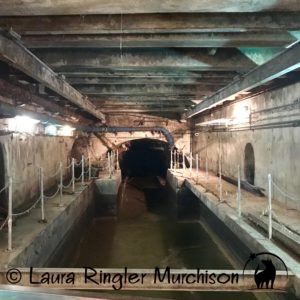
The American satirist Tom Lehrer once crassly quipped, “Life is like a sewer: what you get out of it depends on what you put into it.” The history of water supply and sanitation has been a logistical challenge since the beginning of time. Where water resources, infrastructure, and sanitation systems were insufficient diseases spread, wiping out millions of people like wildfire. Previously my interest in water was pretty much confined to nature and how prior civilizations managed to get it fresh and running to their cities. The Ancient Greeks of Crete were the first to use underground clay pipes. Their capital had a well-organized water system for both bringing in clean water and taking out waste water. The Romans constructed aqueducts — beautiful above ground arches — which moved clean water through gravity alone along a slight overall downward gradient. They supplied public baths, latrines, and private households. Pompeii has always held my fascination, and the horrid erruption of Mount Vesuvius in 79 A.D. left behind a freeze-frame of high-style living, thanks in part to the plumberium. Pompeiian homes featured atriums with an open-roof design, underneath which tanks collected the rainwater that ran down the roof tiles. In Santa Fe I have admired the old Spanish acequias (canals) that were engineered to carry snow runoff from the mountains to distant fields. And the fountains of Versailles are an absolute marvel to me! A hydraulic system still supplies water to the gardens and housing water on the roof of Marie Antionette’s grotto I find as incredible as it was ingenious. In medieval European cities they had small, natural waterways for carrying off sewage and open drains, or gutters that ran along the center of some streets. In Paris they were sometimes known as “split streets,” as the waste water running along the middle physically divided the roads into two halves. The first closed sewer was constructed in Paris as far back as 1370 on Monmartre Street and was almost 985 feet long. The original purpose of designing and constructing a closed sewer was less for waste management as it was to hold back the stench coming from the odorous waste water, according to George Commair’s book, “The Waste Water Network: an underground view of Paris.” The Paris cholera epidemic of 1832 sharpened public awareness of the necessity for some sort of drainage system to deal with sewage in a better and healthier manner. I had heard on an earlier trip to Paris that people used to explore the city’s vast sewers in row boats but was told they put an end to that sometime in the 1970’s. My husband and I decided years ago we wished to explore Paris’ underground. We wanted to tour the sewers as well as the catacombs. However with our five-and-a-half year old in tow, we weren’t sure if she’d be freaked out. Despite her insistence to the contrary, I decided skeletal remains might be too much for the time being and so we decided to just try the Museé des Égouts de Paris; the Paris Sewer Museum. We figured if she didn’t like it we could visit in shifts. All I can say is were we ever surprised! Clearly she is our child: she freaked out alright — but in a good way. She was absolutely FASCINATED and not a bit afraid at all! We found our descent into the bowels of Paris to be (no pun intended) rather sanitized. It was well lit and almost sterile with marked passageways and dark, aged areas cordoned off. Display cases held many an interesting artifact from various points in time, ranging from a fascinating array of swords to a lady’s sequined slipper. Our little one enthusiastically led the way and “explained” to us the mechanics behind it all … despite the fact that she could not read well. She was extremely adept at studying the pictorial explanations, though, and quite a few tourists stop to listen, trying to hide their grins. There was a gift shop and our sweet girl got a souvenir plush rat whom we named Gaspar. Ironically, we completed our visit in time for Burk to use the facilities; luckily he did not have far to go. Perhaps it was indeed what we put into it, but we all took something away from our time in the sewer.

Very interesting Laura!
Thanks Kelly! We thought it was; I’m glad someone else out there found it interesting as well!